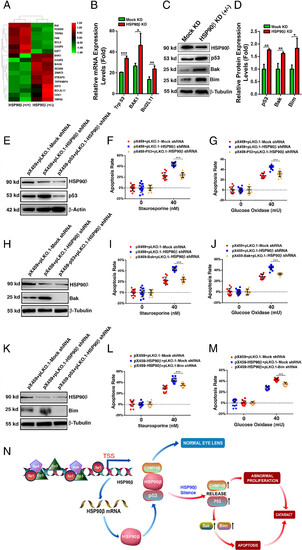Fig. 4
- ID
- ZDB-FIG-231201-62
- Publication
- Fu et al., 2023 - HSP90β prevents aging-related cataract formation through regulation of the charged multivesicular body protein (CHMP4B) and p53
- Other Figures
- All Figure Page
- Back to All Figure Page
|
HSP90β prevents stress-induced apoptosis through suppression of the p53-Bak/Bim pathway activation. (A) Hierarchical cluster analysis of apoptosis-associated genes from RNAseq analysis of pX459-HSP90β-αTN4-1 (HSP90β+/−) and pX459-αTN4-1 (HSP90β+/+) cells. (B) qRT-PCR analysis verified the mRNA expression levels of p53, Bak, and Bim in HSP90β (+/+) αTN4-1 cells and HSP90β (+/−) αTN4-1 cells. (C) Western blot analysis of the expression levels of p53, Bak and Bim in HSP90β (+/+) αTN4-1 cells and HSP90β (+/−) αTN4-1 cells. Note that the expression levels of p53, Bak, and Bim were up-regulated with the downregulation of HSP90β. (D) Quantitative results of (C). (E) Western blot analysis of HSP90β and p53 in pX459+pLKO.1 vectors-αTN4-1 cells [HSP90β (+/+)/p53 (+/+)], pX459+pLKO.1-HSP90β shRNA-αTN4-1 cells [HSP90β (+/−)/p53 (+/+)] and pX459-p53+pLKO.1-HSP90β shRNA-αTN4-1 cells [HSP90β (+/−)/p53 (+/−)]. (F and G) Differential apoptosis rates in the above three types of cells without or with treatment by 40 nM staurosporine or 40 mU/mL GO. The cell viability is measured by the Cell Titer-Lumi™ Luminescent Cell Viability Assay Kit. (H) Western blot analysis of HSP90β and Bak in pX459+pLKO.1 vectors-αTN4-1 cells [HSP90β (+/+)/Bak (+/+)], pX459+pLKO.1-HSP90β shRNA-αTN4-1 cells [HSP90β (+/−)/Bak (+/+)] and pX459-Bak+pLKO.1-HSP90β shRNA-αTN4-1 cells [HSP90β (+/−)/Bak (−/−)]. (I and J) Differential apoptosis rates in the above three types of cells without or with treatment by 40 nM staurosporine or 40 mU/mL GO. The cell viability is measured by the Cell Titer-LumiTM Luminescent Cell Viability Assay Kit. (K) Western blot analysis of HSP90β and Bim in pX459+pLKO.1 vectors-αTN4-1 cells [HSP90β (+/+)/Bim (+/+)], pX459+pLKO.1-HSP90β shRNA-αTN4-1 cells [HSP90β (+/−)/Bim (+/+)] and pX459-Bim+pLKO.1-HSP90β shRNA-αTN4-1 cells [HSP90β (+/−)/Bim (−/−)]. (L and M) Differential apoptosis rates in the above three types of cells without or with treatment by 40 nM staurosporine or 40 mU/mL GO. The cell viability is measured by the Cell Titer-Lumi™ Luminescent Cell Viability Assay Kit. Note that knockout of p53, Bak, or Bim attenuates staurosporine- or GO-induced apoptosis in HSP90β (+/−)-αTN4-1 cells, suggesting that HSP90β prevents stress-induced apoptosis through suppression of p53-Bak/Bim pathway activation. (N) Summary of HSP90β regulation and functions in the ocular lens. Under nonstress induction conditions, the dominant expression of HSP90β is mainly regulated by the Sp1 family transcription factors. The high level of HSP90β can interact with CHMP4B, a newly-found client protein, and p53 to maintain normal cell proliferation and survival to keep lens transparency. Silence of HSP90β induces upregulation of CHMP4B and p53. The increased expression of CHMP4B promotes cell proliferation, and accumulation of the excess number of lens epithelial cells without proper differentiation will cause cataractogenesis. On the other hand, p53 upregulation enhances expression of Bim and Bak, triggering apoptosis of lens epithelial cells, leading to cataractogenesis. Error bar represents SD. *P < 0.05; **P < 0.01; ***P < 0.001. |

